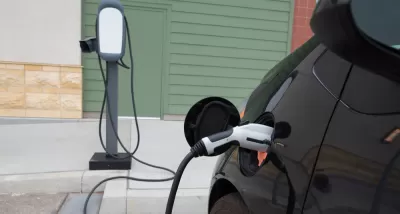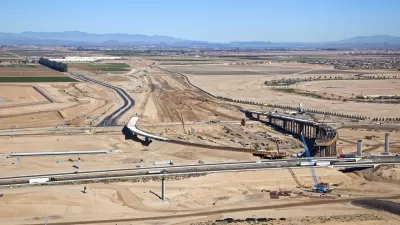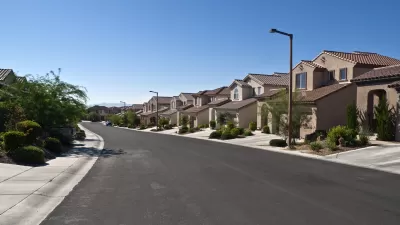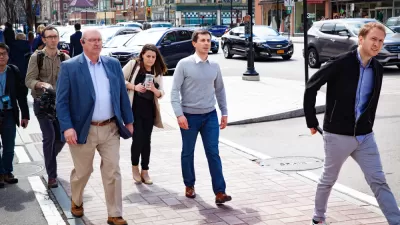Transportation is the biggest contributor to greenhouse gas emissions in the U.S, making President-elect Biden’s choice for Transportation Secretary—and the department’s policies on emissions, electric vehicles, and autonomous vehicles—critical.

The transportation sector is the biggest contributor to greenhouse gas emissions in the United States. As President-elect Biden lays the groundwork for a new administration and prepares to re-enter the Paris Agreement, his cabinet pick for secretary of Transportation, along with his policies on emissions, electric vehicles, and autonomous vehicles will determine the fate of Biden’s ability to hit greenhouse gas (GHG) targets set by the 2016 Paris Agreement.
You can’t possibly take climate change seriously without deep reflection on how our transportation system works. Transportation accounts for almost 30% of all greenhouse gas emissions in the United States, more than any other sector, including agriculture, industry, and even electricity generation.
Which is why Biden’s choice for Transportation Secretary, and the department’s policies on emissions, electric vehicles, and autonomous vehicles is so consequential in the fight to hit critical Paris Agreement goals.
Though counterintuitive, keeping Elaine Chao in the role, Trump’s secretary of Transportation, has its upsides. Chao is married to Senator Mitch McConnell, who is likely to remain Senate Majority Leader. Not only could Chao’s pillow talk act as a bridge across party lines, but the move could also help Biden get a deal on another cabinet post.
Politico has compiled their list of contenders for the top transportation job, with Los Angeles Mayor Eric Garcetti leading the pack. A long-time Biden loyalist and a co-chair of his presidential campaign, Garcetti has also made waves in the transportation world with his innovative policies to reduce congestion and improve public transportation access throughout Los Angeles. Oregon congressman Earl Blumenauer and former Chicago Mayor Rahm Emanual are also on Politico’s list of contenders.
Appointing a reliable democrat like Garcetti has its advantages. Mitigating greenhouse gas emissions is a team sport that will require close coordination with administrators at the Environmental Protection Agency, as well as the State Department, which will run point on coordinating Paris Agreement goals with the global community.
Regardless of who lands the top transportation job, a recent Freight Wave survey reveals that mobility executives, investors, and analysts are preparing for more emissions regulations, more electrification, and increased regulations on autonomous vehicles—policies that are key to hitting Paris Agreement targets.
Reilly Brennan, a partner at TrucksVC, sees incentives coming down the pike for an “EV for clunkers” program to promote the exchange of gas guzzlers for zero-emissions vehicles.
And Sam Abuelsamid, a principal e-mobility analyst with Guidehouse Insights, suspects the federal tax credits for EVs will be expanded. Current federal policy dictates that incentives for purchasing EVs run out once an automaker’s sales hit 200,000, and many electric vehicle companies have run out of their allotted tax credit eligibility.
On emissions, the EPA under Trump rolled back an Obama-era standard that imposed more stringent fuel efficiency rules for cars and trucks. The administration also sought to revoke a California waiver allowing the state to set its own greenhouse gas emissions standards.
But Abuelsamid, who foresees the reinstatement of strict fuel efficiency and greenhouse gas emissions standards rolled back under the Trump administration, told Freight Waves he expects “the EPA to work with California to get more EVs on the road and get a national standard that everyone can agree on for CO2 regulations and adoption of electrification.”
As for connected and automated vehicles, which a 2017 U.S. Energy Information Administration study concluded could lead to a 44 percent reduction of fuel consumption by 2050, industry representatives are optimistic that continued focus on clear automated vehicle regulations will accelerate the proliferation of this technology.
While Barack Obama initiated the first AV guidance, providing a framework for manufacturers and developers for designing, testing, and deploying self-driving cars and trucks, the effort continued under the Trump administration, which released AV 2.0, 3.0, and 4.0.
Shawn Kerrigan, COO and co-founder of Plus, a self-driving trucking technology company, told Freight Waves that he welcomes “strong and clear safety-focused regulations at the local, state and federal levels that are necessary to provide the industry and consumers the confidence needed to roll out this transformative technology.”
Solving our transportation woes is by no means a panacea to combatting climate change, but reducing transportation sourced emissions is certainly a good step in the right direction given the sector’s inflated impact on total U.S. greenhouse gas emissions.
So, whether you voted for Biden or not, let’s hope our president-elect gets transportation right.

Planetizen Federal Action Tracker
A weekly monitor of how Trump’s orders and actions are impacting planners and planning in America.

Map: Where Senate Republicans Want to Sell Your Public Lands
For public land advocates, the Senate Republicans’ proposal to sell millions of acres of public land in the West is “the biggest fight of their careers.”

Restaurant Patios Were a Pandemic Win — Why Were They so Hard to Keep?
Social distancing requirements and changes in travel patterns prompted cities to pilot new uses for street and sidewalk space. Then it got complicated.

California Homeless Arrests, Citations Spike After Ruling
An investigation reveals that anti-homeless actions increased up to 500% after Grants Pass v. Johnson — even in cities claiming no policy change.

Albuquerque Route 66 Motels Become Affordable Housing
A $4 million city fund is incentivizing developers to breathe new life into derelict midcentury motels.

DC Area County Eliminates Bus Fares
Montgomery County joins a growing trend of making transit free.
Urban Design for Planners 1: Software Tools
This six-course series explores essential urban design concepts using open source software and equips planners with the tools they need to participate fully in the urban design process.
Planning for Universal Design
Learn the tools for implementing Universal Design in planning regulations.
Heyer Gruel & Associates PA
JM Goldson LLC
Custer County Colorado
City of Camden Redevelopment Agency
City of Astoria
Transportation Research & Education Center (TREC) at Portland State University
Camden Redevelopment Agency
City of Claremont
Municipality of Princeton (NJ)





























